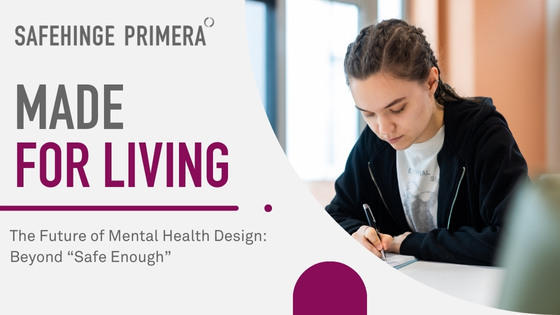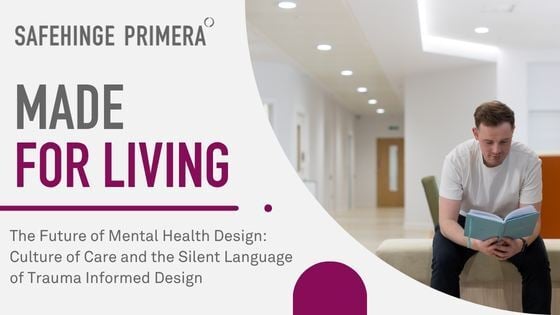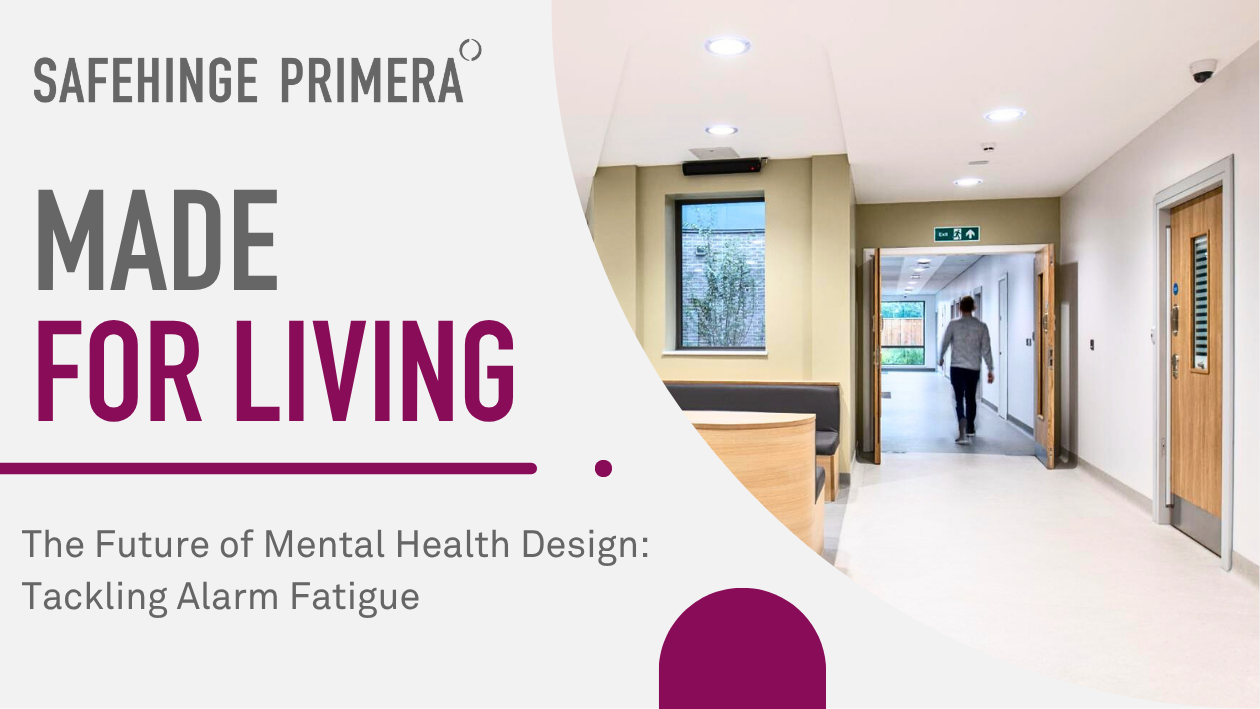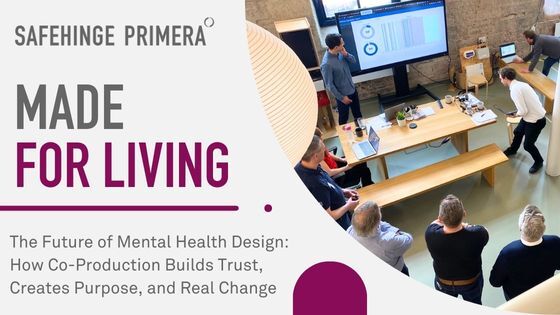“For someone in the midst of a mental health crisis, a door can be the difference between life and death, and between feeling human and feeling forgotten.”
When was the last time you felt truly safe in a space, and also trusted as a person? In your home, your workplace? For many experiencing a mental health crisis, these two feelings don’t always coexist. Consider a quiet psychiatric ward at 2 AM: an alarm sounds at the nurses’ station, not a fire alarm, but an alert from a full-door ligature alarm. Staff hurry to Room 5 and intervene, preventing a potential tragedy, without alerting the entire ward. Minutes later, the patient is in safe hands with staff, comforted, and not stripped of their dignity in the process.
This isn’t a scene from the future; it’s happening now, thanks to thoughtful design that marries safety with compassion. In mental health care environments, every physical detail, from the handles and locks to the layout of a room, can mean the difference between someone feeling protected or feeling punished.
The challenge is clear: how do we keep people safe through their most vulnerable times without making them feel like they’ve lost their worthiness?
The Tension Between Safety and Dignity
In traditional mental health facilities, safety has often come at the cost of personal respect and dignity. Upon admission, it’s still common for service users to be asked to relinquish personal items and wear ill-fitting, hospital-issued clothing for their own protection. Belts, drawstrings, shoelaces, anything that could be used for self-harm, are removed “in the interest of patient safety.” Yet imagine the emotional impact: one patient described feeling “stripped and ashamed” after her clothes were taken for safety reasons¹. The intent was to prevent harm, but the result was a profound loss of autonomy and identity at a moment of crisis.
These seemingly trivial comforts cut to the core of care: Can a person truly heal in an environment that eliminates all risk at the expense of autonomy? A narrow focus on physical safety can inadvertently undermine emotional safety. The World Health Organisation defines patient safety as minimising harm, and crucially, that includes emotional harm. In other words, when we cause a patient needless humiliation or restrict their freedom without clear benefit, we’re causing emotional harm, and that means we’re not actually keeping them “safe” in the holistic sense.
The human toll of getting this balance wrong is significant. Service users who feel humiliated or disrespected are less likely to engage in treatment and may even experience worse outcomes. In fact, being treated as “less than” can deepen trauma and hopelessness. One clinical commentary went so far as to call the undermining of patient dignity an “iatrogenic harm”, a harm caused by the care system itself¹. It’s sobering: rules meant to protect (like environmental restrictions and visual surveillance) can paradoxically increase the risk of self-harm if they make service users feel controlled or disheartened. Clearly, an environment that doesn’t feel human or healing is not truly safe in the broader sense.
Staff experience this tension too. Caregivers face the impossible task of ensuring nothing bad happens, while knowing these strict safety measures can strip away normalcy and trust. Many nurses and doctors have had to enforce policies that make service users feel “othered,” all the while yearning to provide comfort and hope. It’s a heartbreaking irony: the very measures intended to save lives can make life on the ward feel barely worth living. This is the fundamental tension we must resolve: safety and risk versus autonomy and dignity. And the good news is, we’re finally learning how to resolve it.
Designing a Better Balance: Safety With Compassion
The question driving designers and clinicians now is: Why not both? Why can’t a mental health environment be both safe against harm and genuinely welcoming, even empowering, to the people inside? The answers lie in clever innovations, a human-centred approach to design, and relational care.
Why Doors Are at the Centre of the Challenge
Doors within inpatient mental health environments still pose the biggest risk, as the 2024 NCISH report reveals:
- 51% of inpatient suicides involve a door or its hardware, roughly six times the risk of windows (~8%).
- 91% occur in bedrooms or bathroom, spaces where privacy is essential but risk is highest.
It also states that around 80% of in-patient suicides are by hanging or strangulation.
90% of these hangings involve a low-level ligature point (anything below head height), often a door handle, hinge, or frame. It’s not just the top of the door that poses risk; it’s every part of it. That’s why having a system that protects across the entire door is so crucial.
Two hard surfaces meeting, for example frame and leaf, can create a ligature point. But removing the door entirely isn’t an option. Doors are needed for fire safety, soundproofing, and privacy.

The question becomes: How do we design a door that manages risk without erasing humanity?
One UK mental health trust recently grappled with the bathroom door conundrum: How do you give someone the privacy of a real door without the risks? As Tony Gray, a director at the trust, put it: “You want to create an environment where service users feel safe and protected in the bathroom space. But without the right solution, privacy can come at the expense of safety.” His team’s solution was to install new ligature-resistant en-suite doors that were rigorously tested to meet all safety requirements and foster a therapeutic atmosphere. These doors are designed to break away when a ligature is applied. The result?
Since installation in 2022, ligature risks in bathrooms have been reduced by 100%, with zero incidents of service users weaponising the doors. Service users reported feeling safer and more respected in their personal space. Nurses noted that anxiety levels on the ward fell, and service users engaged more in their recovery. In short, the entire environment calmed down.
"We have managed to reduce ligature incidents to zero. You can’t get much safer than that."
Tony Gray, Associate Director of Safety, Security, and Resilience CNTW NHS Foundation Trust
This kind of outcome is achieved through meaningful co-design. It shows what’s possible when engineers, clinicians, and service users themselves work together to rethink how to enable privacy and dignity, whilst ensuring safety.
Modern anti-ligature bedroom door sets show how safety and dignity can go hand in hand. Every detail, from hinge to handle, is designed to remove potential anchor points for self-harm, yet the finished product feels warm and homely, not institutional. That’s intentional. A well-designed door shouldn’t remind someone that they’re in a secure facility. It should blend into the space, creating an environment that feels as close to everyday life as possible.
Technology is also playing a heartening role. That full-door ligature alarm we imagined earlier is very real, in fact, it’s a world-first innovation that turns an entire door into a weight sensor, capable of detecting an attempt to hang or suspend from any part of the door, not just the top edge. Why is this a big deal? Because people going through their most distressed time will find a ligature point wherever one exists, a door handle, hinge, or vision panel. Older alarm systems only monitor the door top and sometimes sides of the door, but they can have gaps of coverage near the door corners where side only sensors can't cover, creating a false sense of safety. Tragically, a recent safety alert detailed how a patient found a ligature point on a door latch that a top-only alarm never detected. Safehinge Primera’s full-door alarm was developed precisely to close those gaps.

It immediately notifies staff if a dangerous load is placed on any part of the door, even if the door is open. And crucially, this system has been designed with sensitivity: it filters out false alarms and integrates with the ward’s existing nurse call systems. Perhaps most importantly, the alarm is concealed within the door and is invisible; nothing bulky or obvious on the door. To the person in the room, it’s just a regular door. But to the staff, it is so much more than a door. It’s a vigilant guardian, watching over that patient in the least intrusive way possible. That is the balance we’re aiming for in modern mental health care - products that are ligature and psychologically safe.
Every one of these innovations, ligature-resistant fixtures, full-door alarms, and even collapsible stops, was developed by listening to the people at the front lines. Safehinge Primera’s engineering design team often says that “great design begins with listening.” In fact, the full-door alarm was created in direct response to clinical feedback and real-world tragedy; hospitals told engineers that service users were finding new ligature points when door top alarms were introduced, so the engineers went back to the drawing board.

It’s a continuous dialogue: staff and service users identify the problem, designers iterate a solution, and the cycle repeats. Co-design, as it’s called, has become a cornerstone of mental health design. Nothing about me without me is the mantra. If you’re designing a space for people in their toughest life moments, you must involve them in the process. The result is solutions that are intuitive, effective, and embraced by everyone who uses them.
As Philip Ross, co-founder of Safehinge Primera, observed, “Co-production is not abdication of design responsibility, it’s translation. We listen carefully, then use our design skills to shape solutions that reflect what people actually need.”. In other words, the best ideas come from those living and working in these spaces. Our job is to translate those ideas into tangible design changes that improve lives. And when we do, the human impact is profound.
Human Stories, Real Impact
What does it feel like to walk into a mental health facility built around these principles of safety and dignity? It feels, in a word, hopeful. Instead of an environment solely focused on what could go wrong, it’s an environment focused on helping things go right.
Picture a patient, let’s call him James, returning to his ward after a difficult therapy session. In the past, he might have been met with a sterile hallway of locked doors and an ever-watchful staff member, a reminder that he was here because he was considered a danger to himself (and others). But today, James walks back to a space that feels almost home-like. His room door is solid and assuring, with a gentle wood finish, and he knows that while it has special sensors to protect him, it also gives him privacy when he needs a moment alone. He can take a shower in his en-suite bathroom without a staff member hovering just outside, yet he’s assured in the knowledge that if something went wrong, someone would know and help would arrive. In the common area, the furniture is soft, without sharp edges, but it looks like it could belong in any modern living room. There’s a social hub down the hall, a cosy room with games, a big window, and a few beanbag chairs, where he can chat with a nurse or fellow service users in a low-pressure setting.
“You know, when I saw that I could lock my own door, that you trusted me that much, I felt safer.”
James, Service User
All these little details are doing something powerful: they are telling James that he is cared for here, not just managed. And that makes him care more about himself. He’d say to a nurse, “You know, when I saw that I could lock my own door, that you trusted me that much, I felt safer.” For James, this could mean a turning point in his recovery.

The power of full-door alarm coverage becomes clear when you think about the realities faced on the frontline. Imagine a ward manager, let’s call him Mark, with more than 20 years’ experience. Like so many in his role, blind spots in some alarm systems kept him awake at night. What if someone found the one part of the door the system missed? What if staff didn’t notice in time? These are the questions going through his mind.
It’s not an uncommon scenario. In the past, patients have attempted self-harm at points like the hinge side of a bedroom door, where traditional alarms offered no protection. Staff intervention for these scenarios should not be left to chance.
Now, things are changing. With a full-door ligature alarm solution, even pressure at the very base of the door is detected instantly. Staff are alerted within seconds, arriving quickly and preventing escalation. Instead of panic and force, the response is calm, controlled, and compassionate, treating the person as someone in distress, not a threat.
Wards feel protective, not punitive, and with fewer ‘what ifs’ to carry home, staff can focus on care with confidence.
These are the kind of human-centric outcomes that happen when you rethink the physical space and policies together. And they’re backed up by data as well. In facilities that have embraced this balanced design philosophy, the numbers tell a hopeful story: fewer suicide attempts, fewer restraints, shorter hospital stays, a reduction in seclusion room use, and higher satisfaction for both service users and staff.
“By giving people even small moments of agency, we create a far greater sense of safety than any locked door ever could.”
Clinical Team Feedback
One large NHS trust in England reported virtually eliminating ligature-related incidents after overhauling their door systems and other fixtures. Service users in those wards, when surveyed, said they felt safer and more respected, and nurses reported lower stress and burnout levels. It turns out that a ward designed for dignity is a better workplace, too. Staff feel proud of where they work because it aligns with why they became carers in the first place.
One clinician summed it up brilliantly: “By giving people even small moments of agency, we create a far greater sense of safety than any locked door ever could.” Real safety is achieved with people, not against them. And that philosophy is now guiding the future of mental health infrastructure.
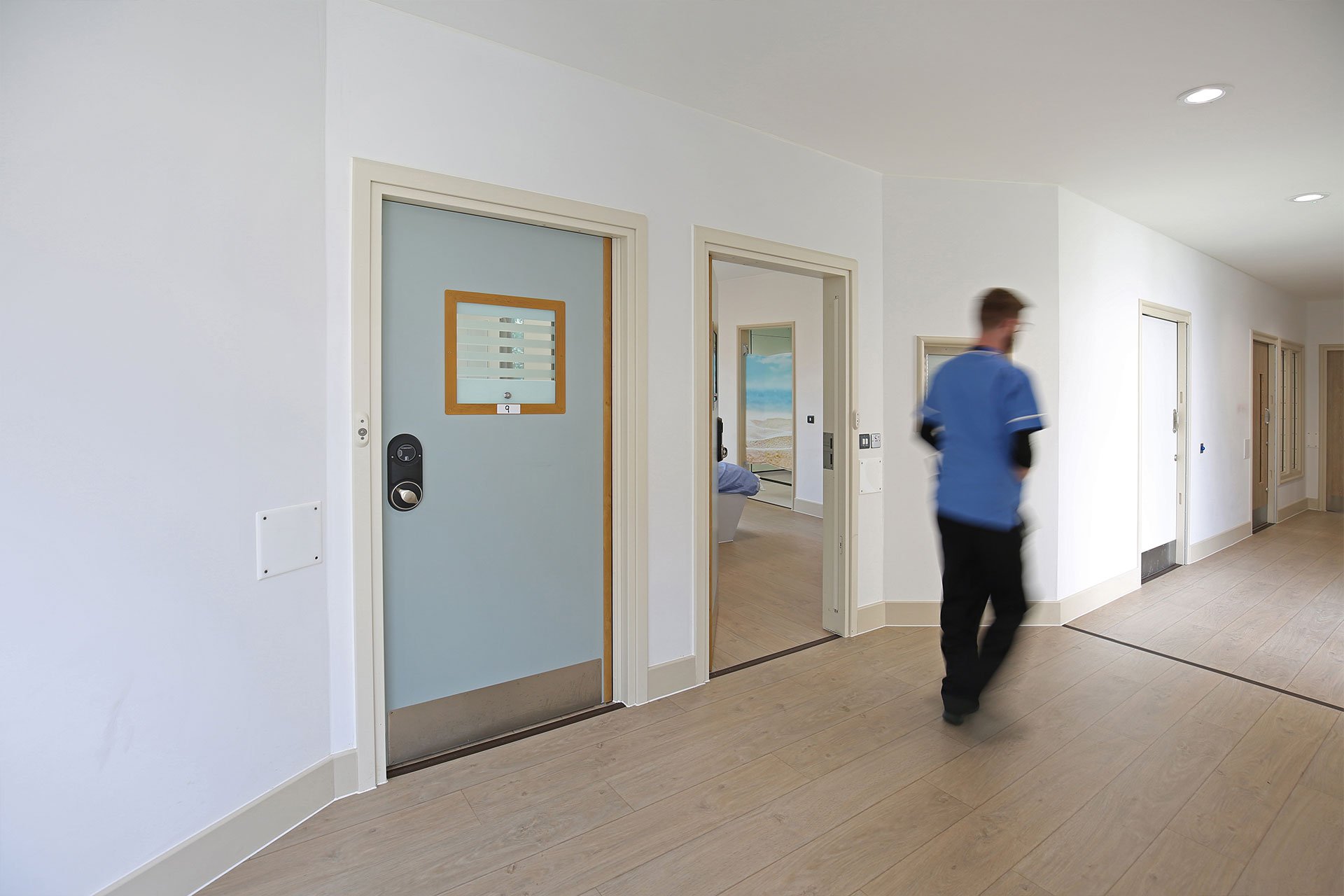
Toward Hopeful, Healing Environments
If there’s one insight driving the next generation of mental health design, it’s this: dignity is essential, and it’s a lifeline. We no longer see safety and dignity as opposing forces to trade off, but as equal pillars of therapeutic design. This shift is ushering in environments that feel very different from the psychiatric units of the past. They feel, dare we say, more normal, more human.
That means architects and hospital planners are asking new questions. Instead of “How do we make sure nobody can hurt themselves here?” the question becomes “How do we design this space so that it naturally encourages well-being and minimises harm, while still feeling like a living space?”. The answers span big and small ideas: soft furnishings, calming colors, and artwork that soothes; clear sightlines so staff can monitor discreetly; “safety by design” features like tamper-proof fixtures, and breakaway hooks that don’t broadcast themselves loudly; private nooks where a person can retreat without feeling isolated; even outdoor gardens and natural light to remind everyone that there is hope and life awaits beyond the ward. It all comes back to empowering the individual: sending the message that “You still have choices. You still have a life to live, and we’re here to help you get back to it.”
Crucially, this approach also acknowledges the needs of staff and families. A safe-but-dismal ward wears down the people who work there as well as visitors. By contrast, a ward that nailing this new balance tends to have more engaged, optimistic staff, and that energy is infectious. Visitors feel it too. Relieved to see their loved one in a space that feels healing rather than clinical, they’re more likely to visit regularly and invite others to come along, bringing comfort, more connection, and renewed hope that supports recovery. Hope is contagious. When we build environments that inspire hope, we’re essentially building better outcomes from the ground up for everyone, like a single drop of water with a big ripple effect. As the team at Safehinge Primera likes to say, “Every product is part of a bigger picture: making hope visible through design. When a place shows you through its little details that tomorrow can be better, you start to believe it.
It's Not About Doors at all
At the end of the day, none of these changes are about doors or alarms (someone pinch us, please) or architecture per se. They’re about people. They’re about treating a patient in mental and emotional pain, not as a problem to be managed, but as a person to be protected and respected. They’re about treating frontline staff not as security guards, but as healers who deserve environments that set them up for success. Good design in mental health care should not be about making a facility good enough; it has to have the human experience at the very center of every decision. Because when we do that, safety naturally follows.
So as we envision the future of mental health infrastructure, let’s hold ourselves to this higher standard. Let’s be curious: keep asking, “Is this the best we can do? What if we tried another way?” Let’s be determined: never accepting that a harmful trade-off is “just how it is.” And above all, let’s remain conscientious: remembering that every design choice, no matter how technical, affects a real person’s well-being, their family, their carer, and the entire industry. We owe it to those we serve to get this right. The momentum is on our side: every success story, every saved life, and every patient smiling at discharge fuel the movement for more humane, hopeful mental health spaces.
Join the Conversation
At Safehinge Primera, we live by our purpose: “We help protect people through vulnerable times.” That mission drives us to keep innovating and advocating for environments where safety and dignity walk hand in hand. But we know we don’t have all the answers and we don’t want to design in a vacuum.
Let’s keep this conversation going, together. Whether you’re a healthcare professional, a designer, a caregiver, or someone with lived experience, your perspective can spark the next big improvement.
Connect with our team, share your stories, or explore our latest solutions. We’re all ears and open doors (we couldn’t help it).
Sources:
